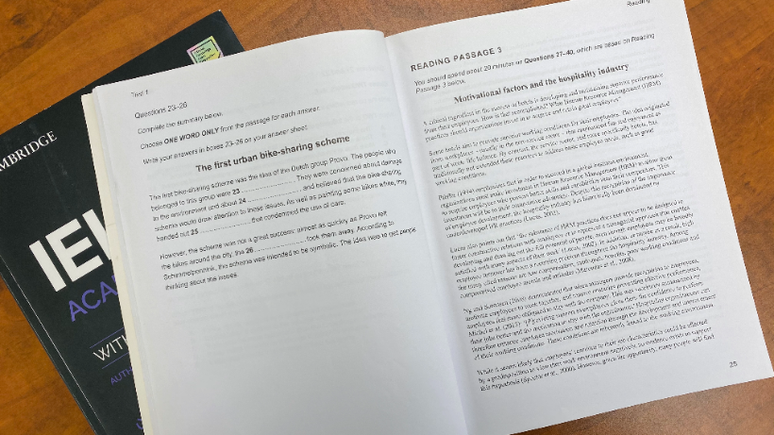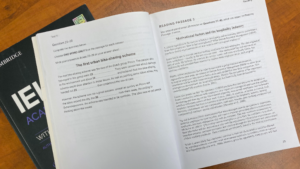IELTSアカデミックのリーディングは、多方面にわたる学術的な内容の長文が3つ出題されます。
この記事では、IELTSリーディングの概要と問題形式について紹介していきます。
IELTSリーディングの構成
IELTSアカデミックのリーディングは、2ページ程に渡る長文が3つ(3パッセージ)出題されます。
3パッセージ合わせて、制限時間が60分、設問数は40問で構成されています。
それぞれの文章は、実際に使用されている書籍、雑誌、新聞からの抜粋されています。
- 社会、歴史、科学、伝記、自然、技術、地理、環境
- ニュース、時事問題はない
- 政治、宗教、経済は出ない傾向
- 専門用語の知識は必要ない
リーディングの特徴
IELTSリーディングの特徴は、次のようにまとめることができます。
- パッセージは全部で3つ
- パッセージはそれぞれ700〜1000語程度の長文(約2ページ分)
- 設問数は、それぞれの長文で12〜13問ほど
- 動物関連の記事や環境問題がテーマになることが多い
- リスニングと異なり、解答用紙に書き込む時間は与えられないので、解きながら直接答えを書き込んでいく
リーディングの解き方
リーディングでは、60分で解かなければならないので、1パッセージ当たり20分で解くことを目安としましょう。
ただし、パッセージの難易度が次のように設定されているので、問題によって配分を変える必要があります。
- 1つ目のパッセージが最も易しい
- 2つ目、3つ目のパッセージの難易度はほぼ同じ
- 2つ目、3つ目のどちらかの難易度が最も高い
IELTS アカデミック リーディングスコア換算表
IELTSのリーディングでは、正解数に応じてバンドスコアが決まります。
目標スコアに応じて対策法も変わってきますので、自分に必要な正答数を覚えておきましょう。
| スコア | 9 | 8.5 | 8 | 7.5 | 7 | 6.5 | 6 | 5.5 | 5 | 4.5 | 4 | 3.5 | 3 | 2.5 |
| 正解数 | 39-40 | 37-38 | 35-36 | 33-34 | 30-32 | 27-29 | 23-26 | 19-22 | 15-18 | 13-14 | 10-12 | 8-9 | 6-7 | 4-5 |
IELTSリーディングの問題形式と対策
IELTSのリーディングには、IELTS特有の問題形式があります。
問題形式を把握し、問題慣れしておくことで、設問を読む時間が短縮でき、正答率も高くなります。
①要約穴埋め問題
②情報穴埋め問題
③タイトルマッチング問題
④文章穴埋め問題
⑤TRUE / FALSE / NOT GIVEN 問題
⑥選択問題(人の名前)
⑦文章完成問題
⑧選択問題(四択か三択)
⑨テーブル完成問題
① 要約穴埋め問題(選択式)
この問題では、本文の内容が要約されている文章の中に、適切な語句を選択し、埋めていきます。
本文のキーワードが書き換えられている可能性が高いので、同じ意味の単語を本文から探し出しましょう。
例題
IELTS ケンブリッジ問題集からの一部抜粋
Bring back the big cats
There will be no threat to human beings by the lynx: there is no instance of a lynx preying on people. It is a specialist predator of roe deer that has exploded in Britain in recent decades which holds back the intensive browsing and planning to re-establish forests. It will also winkle out sika deer, an exotic species that is impossible for human beings to control as it hides in impenetrable plantations of young trees. Reintroducing this predator comes with the aim of bringing back the forests to the parts of our bare and barren uplands. The lynx needs deep cover thus giving little risk to sheep and other livestock which need to be in a condition of farm subsidies that are kept out of the woods.
Several conservationists suggested that the lynx can be reintroduced within 20 years in the recent trip of the Cairngorm Mountains. If trees return to the bare hills anywhere in Britain, the big cats will follow. If it is seen from the perspective of anywhere else in Europe, there will be nothing extraordinary about the proposals. Now, the lynx has been reintroduced to the Mountains, Alps in eastern France and mountains in Germany and re-established in many places. Since 1970, the European population has tripled to nearly 10, 000. Like wolves, bears, pigs, bison, moose and other species, the lynx will spread as farming, left the hills and then people discover that it is much needed to protect wildlife than to hunt it as tourists will pay to see it. Large scale rewilding will happen everywhere except Britain.
Questions 19-22
Complete the summary using the list of words and phrases A-F below.
Write the correct letter, A-F, in boxes 19-22 on your answer sheet.
Reintroducing the Lynx to Britain
There would be many advantages to reintroducing the lynx to Britain. While there is no evidence that the lynx has ever put 19.……………..in danger, it would reduce the numbers of certain 20……………….whose populations have increased enormously in recent decades. It should present only a minimal threat to 21……………….., provided these were kept away from lynx habitats. Furthermore, the reintroducing programme would also link efficiently with initiatives to return native 22………………..to certain areas of the country.
| A trees | B endangered species | C hillsides |
| D wild animals | E humans | F farm animals |
解答と解説
19
解答: E. humans
本文では “No threat to human being” と書かれていることに注目しましょう。
20
解答: D. wild animals
本文では “Roe deer, a species that has exploded in Britain in recent decades” と書かれていることに注目しましょう。
21
解答: F. farm animals
本文では “presents little risk to sheep and other live stocks” と書かれていることに注目しましょう。
22
解答: A. trees
本文では “with the aim to bringing forests back to parts of our bare and barren uplands” と書かれていることに注目しましょう。
② 情報穴埋め問題
この問題は、3語、もしくは2語、1語の単語を本文から抜き出して穴埋めする問題です。指示文に注意しましょう。
Choose NO MORE THAN TWO WORDS from the passage for each answer.
(ONE WORD ONLY の場合もあります)
この指示では、2語抜き出してもいいし、1語のみの抜き出しもできるという意味です。
ONE WORD ONLYと書かれている場合は、1語のみ抜き出しましょう。
例題
IELTS ケンブリッジ問題集からの一部抜粋
Music and the emotions
A recent paper in Neuroscience by a research team in Montreal, Canada, marks an important step in repealing the precise underpinnings of ‘the potent pleasurable stimulus’ that is music. Although the study involves plenty of fancy technology, including functional magnetic resonance imaging (fMRI) and ligand-based positron emission tomography (PET) scanning, the experiment itself was rather straightforward. After screening 217 individuals who responded to advertisements requesting people who experience ‘chills’ to instrumental music, the scientists narrowed down the subject pool to ten. They then asked the subjects to bring in their playlist of favourite songs – virtually every genre was represented, from techno to tango – and played them the music while their brain activity was monitored. Because the scientists were combining methodologies (PET and fMRI), they were able to obtain an impressively exact and detailed portrait of music in the brain. The first thing they discovered is that music triggers the production of dopamine – a chemical with a key role in setting people’s moods – by the neurons (nerve cells) in both the dorsal and ventral regions of the brain. As these two regions have long been linked with the experience of pleasure, this finding isn’t particularly surprising.
What is rather more significant is the finding that the dopamine neurons in the caudate – a region of the brain involved in learning stimulus-response associations, and in anticipating food and other ‘reward’ stimuli – were at their most active around 15 seconds before the participants’ favourite moments in the music. The researchers call this the ‘anticipatory phase’ and argue that the purpose of this activity is to help us predict the arrival of our favourite part. The question, of course, is what all these dopamine neurons are up to. Why are they so active in the period preceding the acoustic climax? After all, we typically associate surges of dopamine with pleasure, with the processing of actual rewards. And yet, this cluster of cells is most active when the ‘chills’ have yet to arrive, when the melodic pattern is still unresolved.
Questions 27-31
Complete the summary below.
Choose NO MORE THAN TWO WORDS from the passage for each answer.
Write your answers in boxes 27-31 on your answer sheet.
The Montreal Study
Participants, who were recruited for the study through advertisements, had their brain activity monitored while listening to their favourite music. It was noted that the music stimulated the brain’s neurons to release a substance called 27………………in two of the parts of the brain which are associated with feeling 28…………………
Researchers also observed that the neurons in the areas of the brain called the 29…………………….were particularly active just before the participants’ favorite moments in the music – the period known as the 30………………….. Activity in this part of the brain is associated with the expectation of ‘reward’ stimuli such as 31…………………..
解答と解説
27
解答:dopamine
called xxx ということは xxx という名称が入ると予測できます。そしてそれが脳の2つの部分でリリースされると問題に書いてあります。
28
解答:pleasure
化学物質が何の感情に関連しているかと聞かれています。”associated with” が本文では、”linked with” で書き換えられています。
29
解答:caudate
ここの問題は次の2段落目に記載されています。xxx と呼ばれるという脳の箇所が聞かれているので、脳の部分的な名称が入ると想像できます。そして、それは好きな音楽を聴くちょうど前にアクティブになると述べられています。
本文の、”the dopamine neurons in the caudate – a region of the brain involved in learning stimulus-response associations, and in anticipating food and other ‘reward’ stimuli – were at their most active around 15 seconds before the participants’ favourite moments in the music.” から解答が引き出せるでしょう。
30
解答:anticipatory phase
31
解答 : food
この設問タイプでは、情報が1つの段落、もしくは次の段落にまたがって記載されることがほとんどです。
全く異なった3つ以上の段落から探してくることは稀で、本文の一部分に全ての情報が記載されています。
ただし、順番通りに情報が記述されていない場合もあります。例題では、31番の問題が29番の解答よりも前に述べられています。
③ タイトルマッチング問題 (見出しマッチング)
タイトルマッチング問題は、本文の段落のタイトルとして、ふさわしいものを選択肢の中から選ぶ形式です。
ヘッディング問題とも呼ばれ、段落の最初の文章(トピックセンテンス)から答えがすぐにわかるものもありますが、大体は全体的な内容を理解していないとと答えられません。
この問題を解く時は、まず本文の最初の段落(Aの段落)を読み、選択肢から当てはまるものを選びます。
次にBの段落を読み、同じように選択肢の中からふさわしいものを選ぶ、というように、段落を読む度に問題を解いていきます。そのため、消去法が役に立ちます。
例題 3
IELTS ケンブリッジ問題集からの一部抜粋
The Desolenator: producing clean water
A
Traveling around Thailand in the 1990s, William Janssen was impressed with the basic rooftop solar heating systems that were on many homes, where energy from the sun was absorbed by a plate and then used to heat water for domestic use. Two decades later Janssen developed that basic idea he saw in Southeast Asia into a portable device that uses the power from the sun to purify water.
B
The Desolator operates as a mobile desalination unit that can take water from different places, such as the sea, rivers, boreholes, and rain, and purify it for human consumption. It is particularly valuable in regions where natural groundwater reserves have been polluted, or where seawater is the only water source available.
Janssen saw that there was a need for a sustainable way to clean water in both the developing and the
developed countries when he moved to the United Arab Emirates and saw large-scale water processing.
‘I was confronted with the enormous carbon footprint that the Gulf nations have because of all of the
desalination that they do,’ he says.
Questions 14-20
Reading passage 2 has seven sections, A-G.
Choose the correct heading for each section from the list of headings below.
Write the correct number, i-vi, in boxes 14-20 on your answer sheet.
List of Headings
i Getting the fiance for production
ii An unexpected benefit
iii From initial inspiration to new product
iv The range of potential customers for the device
v What makes the device different from alternatives
vi Cleaning water from a range of sources
※一部省略しています
解答と解説
14
解答:ⅱ
本文の段落Aを読むと、William Janssenさんのタイに行ったときに印象深かったソーラーエネルギーのことについて述べられていて、20年後にその経験をもとにソーラーエネルギーを使って水をきれいにするアイデアを発展させたことが述べています。
15
解答:ⅵ
トピックセンテンスですぐ解答が見つかりました。”The Desolator operates as a mobile desalination unit that can take water from different places, such as the sea, rivers, boreholes, and rain,” (Desolatorは持ち運びできる淡水化ユニットとして機能します。そして様々なところから水を組み入れることができます。例えば海、川、試掘用の穴などからです。)
④ 文章穴埋め問題
「Sentence completion」と言われ、ONE WORD or NO MORE THAN TWO WORDS(1語か2語)など、問題ごとに語数が指定され、本文から空欄に当てはまる適切な単語を抜き出します。
空欄に入るのは、ほとんどの場合は名詞ですが、副詞など別の品詞が入ることもあります。
この問題では、本文から単語をそのまま抜き出して答える必要があるので、次の点に注意しましょう。
- 品詞を変える
- 複数形を単数形で書く
- スペルミスをする
例題 4
IELTS ケンブリッジ問題集からの一部抜粋
Silbo Gomero- the Whistle Language of the Canary Islands
La Gomera is one of the Canary Islands situated in the Atlantic Ocean off the northwest coast of Africa. This small volcanic island is mountainous, with steep rocky slopes and deep, wooded ravines, rising to 1,487 metres at its highest peak. It is also home to the best known of the world’s whistle languages’, a means of transmitting information over long distances which is perfectly adapted to the extreme terrain of the island.
This ‘language, known as ‘Silbo’ or ‘Silbo Gomero – from the Spanish word for ‘whistle’ – is now shedding light on the language-processing abilities of the human brain, according to scientists. Researchers say that silbo activates parts of the brain normally associated with spoken language, suggesting that the brain is remarkably flexible in its ability to interpret sounds as language.
‘Science has developed the idea of brain areas that are dedicated to language, and we are starting to understand the scope of signals that can be recognised as language, says David Corina, co-author of a recent study and associate professor of psychology at the University of Washington in Seattle.
Silbo is a substitute for Spanish, with individual words recoded into whistles which have high- and low-frequency tones. A whistler or silbador puts a finger in his or her mouth to increase the whistle’s pitch, while the other hand can be cupped to adjust the direction of the sound.”There is much more ambiguity in the whistled signal than n the spoken signal, explains lead researcher Manuel Carreiras, psychology professor at the University of La Laguna on the Canary island of Tenerife. Because whistled ‘words’ can be hard to distinguish, silbadores rely on repetition, as well as awareness of context, to make themselves understood.
Questions 20-26
Complete the notes below.
Choose ONE WORD ONLY from the passage for each answer.
Write your answers in boxes 20-26 on your answer sheet.
Siblo Gomero
How Silbo is produced
- high-and low-frequency tones represent different sounds in Spanish 20…………………….
- pitch of whistle is controlled using silbador’s 21………………………..
- 22………………….. is changed with a cupped hand
How Silbo is used
- has long been used by shepherds and people living in secluded locations
- in everyday use for the transmission of brief 23………………………….
- can relay essential information quickly, e.g. to inform people about 24………………….
解答と解説
20
解答:words
問題文のキーワード、High and low frequency tonesが記載されている段落を特定しましょう。
4段落目の最初の文にありました。”Silbo is a substitute for Spanish, with individual words recoded into whistles which have high- and low-frequency tones.”
問題文では、Silbo は高周波数と低周波数のトーンを出し、それはスペイン語のxxx の異なった音を代表しますと述べています。本文では、「Silboはスペイン語の代わりに使われ、それの各単語は高周波数と低周波数を持つ口笛で表示される」という意味を掴めば、高周波数と低周波のトーンが、異なったスペイン語の単語に影響されることが分かります。
21
解答:finger
同じセクションの問題なので、20番と同じ段落に解答がみつかる可能性が高いです。読み進めていくと2行目に “A whistler or silbador puts a finger in his or her mouth to increase the whistle’s pitch”と書かれています。ピッチはsilbadorの何を使ってコントロールされているかが解答になります。
22
解答:direction
問題文の ”cupped hand”がキーワードです。21番を解いた本文のすぐ後ろに、”while the other hand can be cupped to adjust the direction of the sound”とあります。 hand can be cupped が cupped handと言い換えられています。
⑤ TRUE / FALSE / NOT GIVEN 問題
IELTSのリーディングで非常によく出る、IELTS特有の問題形式のひとつです。
設問の文章について “True/ False/ Not Given” か、または “Yes/ No/ Not Given” かを選ぶ問題です。
- True/ Yes:本文に対して正しい
- False/ No:本文に対して間違っている
- Not Given:与えられていない情報
「False」は情報が書いてあるけれども、間違っている場合
「Not Given」 は情報が記載されていないので、その情報が間違いか、正しいか、判断することができない場合
解答時に、それぞれを省略し、「T」「F」「NG」と、頭文字だけ書き込まないように気を付けましょう。
自習の際に頭文字だけで書く癖がつき、実際のテストでも書いてしまうケースが多いです。普段からアルファベットで書くようにしましょう。
この問題については、次の記事でより詳しく紹介しています。


⑥ 選択問題(人の名前)
本文に人名が2つ以上出てきた場合、それぞれの人の発言はどれかを選ぶ選択問題が出題される可能性があります。
本文をざっと読んでいる最中に人の名前が頻繁に出てきた場合は、必ずそれぞれの人名に印をつけておきましょう。
設問で示されている情報は、ほとんどの場合、人名の前後に示されるため、印をつけておけば情報をすぐ探すことができます。
【例題 6】IELTS ケンブリッジ問題集からの一部抜粋
The risks agriculture faces in developing countries
A
Two things distinguish food production from all other productive activities: first, every single person needs food each day and has a right to it; and second, it is hugely dependent on nature. These two unique aspects, one political, the other natural, make food production highly vulnerable and different from any other business. At the same time, cultural values are highly entrenched in food and agricultural systems worldwide.
B
Farmers everywhere face major risks; including extreme weather, long-term climate change, and price volatility in input and product markets. However, smallholder farmers in developing countries must in addition deal with adverse environments, both natural, in terms of soil quality, rainfall, etc. and human, in terms of infrastructure, financial systems, markets, knowledge and technology. Counter-intuitively, hunger is prevalent among many smallholder farmers in the developing world.
C
Participants in the online debate argued that our biggest challenge is to address the underlying causes of the agricultural system’s inability to ensure sufficient food for all, and they identified as drivers of this problem our dependency on fossil fuels and unsupportive government policies.
D
On the question of mitigating the risks farmers face, most essayists called for greater state intervention.
In his essay, Kanayo F. Nwanze, President of the International Fund for Agricultural Development, argued that governments can significantly reduce risks for farmers by providing basic services like roads to get produce more efficiently to markets, or water and food storage facilities to reduce losses. Sophia Murphy, senior advisor to the Institute for Agriculture and Trade Policy, suggested that the procurement and holding of stocks by governments can also help mitigate wild swings in food prices by alleviating uncertainties about market supply.
E
Shenggen Fan, Director General of the International Food Policy Research Institute, held up social safety nets and public welfare programmes in Ethiopia, Brazil and Mexico as valuable ways to address poverty among farming families and reduce their vulnerability to agriculture shocks. However, some commentators responded that cash transfers to poor families do not necessarily translate into increased food security, as these programmes do not always strengthen food production or raise incomes.
Regarding state subsidies for agriculture, Rokeya Kabir, Executive Director of Bangladesh Nari Progati Sangha, commented in her essay that these ‘have not compensated for the stranglehold exercised by private traders.
In fact, studies show that sixty percent of beneficiaries of subsidies are not poor, but rich landowners and non-farmer traders.
F
Nwanze, Murphy and Fan argued that private risk management tools, like private insurance, commodity futures markets, and rural finance can help small-scale producers mitigate risk and allow for investment in improvements. Kabir warned that financial support schemes often encourage the adoption of high-input agricultural practices, which in the medium term may raise production costs beyond the value of their harvests.
Murphy noted that when futures markets become excessively financialised they can contribute to short-term price volatility, which increases farmers’ food insecurity. Many participants and commentators emphasised that greater transparency in markets is needed to mitigate the impact of volatility, and make evident whether adequate stocks and supplies are available. Others contended that agribusiness companies should be held responsible for paying for negative side effects.
G
Many essayists mentioned climate change and its consequences for small-scale agriculture. Fan explained that in addition to reducing crop yields, climate change increases the magnitude and the frequency of extreme weather events, which increase smallholder vulnerability. The growing unpredictability of weather patterns increases farmers’ difficulty in managing weather-related risks.
According to this author, one solution would be to develop crop varieties that are more resilient to new climate trends and extreme weather patterns. Accordingly, Pat Mooney, co-founder and executive director of the ETC Group, suggested that ‘if we are to survive climate change, we must adopt policies that let peasants diversify the plant and animal species and varieties/breeds that make up our menus.
H
Some participating authors and commentators argued in favour of community- based and autonomous risk management strategies through collective action groups, co-operatives or producers’ groups. Such groups enhance market opportunities for small-scale producers, reduce marketing costs and synchronise buying and selling with seasonal price conditions.
According to Murphy, ‘collective action offers an important way for farmers to strengthen their political and economic bargaining power, and to reduce their business risks. One commentator, Giel Ton, warned that collective action does not come as a free good. It takes time, effort and money to organise, build trust and to experiment. Others, like Marcel Vernooij and Marcel Beukeboom, suggested that in order to ‘apply what we already know’, all stakeholders, including business, government, scientists and civil society, must work together, starting at the beginning of the value chain.
Questions 4-9
Look at the following statements and the list of people below.
Match each statement with the correct person, A-G.
Write the correct letter, A-G, in boxes 4-9 on your answer sheet.
NB You may use any letter more than once.
【例題 6】IELTS ケンブリッジ問題集からの抜粋
Questions 4-9
Look at the following statements and the list of people below.
Match each statement with the correct person, A-G.
Write the correct letter, A-G, in boxes 4-9 on your answer sheet.
NB You may use any letter more than once.
4 Financial assistance from the government does not always go to the farmers who most need it
5 Farmers can benefit from collaborating as a group
6 Financial assistance from the government can improve the standard of living of farmers.
7 Farmers may be helped if there is financial input by the same individuals who buy for them.
8 Governments can help to reduce variation in prices.
9 Improvements to infrastructure can have a major impact on risk for farmers.
List of People
A Kanayo F. Nwanze
B Sophia Murphy
C Shenggen Fan
D Rokeya Kabir
E Pat Mooney
F Giel Ton
G Sonali Bisht
解答と解説
4
解答:D
言い換えられている箇所を探す作業になりますが、Eの段落の2段落目の最後の方に、”In fact, studies show that sixty percent of beneficiaries of subsidies are not poor, but rich landowners and non-farmer traders.”と書かれています。「60%の補助金の受給者は貧しくはなく、だいたいはお金持ちの土地所有者と非農業トレーダーです。」と書かれています。Rokeya Kabir が研究で述べていること記載している段落なので、答えはDです。
5
解答:D
Hの段落で、”collective action offers an important way for farmers to strengthen their political and economic bargaining powerfarmers” つまり、「農家の人たちがが一緒になって協力することで経済的かつ政治的な発言力が増す」と書いてあります。collaborateing が Collective actionで言い換えられています。Murphyさんなので、B が正解です。
6
解答:C
「政府からの補助金が農家の生活水準を上げることができる」と述べています。financial assistanceとstandard of living がキーワードですので、本文の名前の近くから探していきましょう。Eの段落の “Shenggen Fan, Director General of the International Food Policy Research Institute, held up social safety nets and public welfare programmes in Ethiopia, Brazil and Mexico as valuable ways to address poverty among farming families” を見てみると、social safety netと書かれています。これは「安全網」といい、政府が行う救済措置のことです。welfare programmesは生活保護です。生活保護は生活水準に見合わない方がお金を政府から受給されるシステムです。そしてそれが、貧困を改善する貴重な方法だと言っています。ですので Shenggen FanさんのCが正解です。
NB You may use any letter more than once.
「一つのアルファベット(選択肢)を何度も使う可能性もあります。」に注意しましょう。
このように記載されているときはほぼ100%の割合で同じアルファベットが使用されます。逆に、この注意書きがなければ、それぞれの選択肢を1回しか使いません。
⑦ 文章完結問題
matching sentence endings と言われる問題です。
本文の内容と一致するよう、設問文に続くのにふさわしいものを選び、文を完成させる問題です。
設問の前半部分にふさわしいものを選ぶ場合もあり、選択肢は設問の数より多いので、使用しないものもあります。
また、設問は本文に記載されている順番通りに出題されます。
例題 7
IELTS ケンブリッジ問題集 からの抜粋
Why fairy tales are scary tales
Some people think that fairy tales are just stories to amuse children, but their universal and
enduring appeal may be due to more serious reasons
People of every culture tell each other fairy tales but the same story often takes a variety of
forms in different parts of the world. In the story of Little Red Riding Hood that European
children are familiar with, a young girl on the way to see her grandmother meets a wolf and
tells him where she is going. The wolf runs on ahead and disposes of the grandmother, then
gets into bed dressed in the grandmother’s clothes to wait for Little Red Riding Hood. You may
think you know the story – but which version? In some versions, the wolf swallows up the
grandmother, while in others it locks her in a cupboard. In some stories, Red Riding Hood gets
the better of the wolf on her own, while in others a hunter or a woodcutter hears her cries and
comes to her rescue.
The universal appeal of these tales is frequently attributed to the idea that they contain
cautionary messages: in the case of Little Red Riding Hood, to listen to your mother, and avoid
talking to strangers. ‘It might be what we find interesting about this story is that it’s got this
survival-relevant information in it,’ says anthropologist Jamie Tehrani at Durham University in
the UK. But his research suggests otherwise. ‘We have this huge gap in our knowledge about
the history and prehistory of storytelling, despite the fact that we know this genre is an
incredibly ancient one,’ he says. That hasn’t stopped anthropologists, folklorists* and other
academics devising theories to explain the importance of fairy tales in human society. Now
Tehrani has found a way to test these ideas, borrowing a technique from evolutionary biologists
To work out the evolutionary history, development and relationships among groups of
organisms, biologists compare the characteristics of living species in a process called
‘phylogenetic analysis’. Tehrani has used the same approach to compare related versions of fairy
tales to discover how they have evolved and which elements have survived longest.
Tehrani’s analysis focused on Little Red Riding Hood in its many forms, which include another
Western fairy tale known as The Wolf and the Kids. Checking for variants of these two tales and
similar stories from Africa, East Asia and other regions, he ended up with 58 stories recorded
from oral traditions. Once his phylogenetic analysis had established that they were indeed
related, he used the same methods to explore how they have developed and altered over time.
First, he tested some assumptions about which aspects of the story alter least as it evolves,
indicating their importance. Folklorists believe that what happens in a story is more central to
the story than the characters in it – that visiting a relative, only to be met by a scary animal in
disguise, is more fundamental than whether the visitor is a little girl or three siblings, or the
animal is a tiger instead of a wolf.
However, Tehrani found no significant difference in the rate of evolution of incidents compared
with that of characters. ‘Certain episodes are very stable because they are crucial to the story,
but there are lots of other details that can evolve quite freely,’ he says. Neither did his analysis
support the theory that the central section of a story is the most conserved part. He found no
significant difference in the flexibility of events there compared with the beginning or the end.
But the really big surprise came when he looked at the cautionary elements of the story.
‘Studies on hunter-gatherer folk tales suggest that these narratives include really important
information about the environment and the possible dangers that may be faced there – stuff
that’s relevant to survival,’ he says. Yet in his analysis such elements were just as flexible as
seemingly trivial details. What, then, is important enough to be reproduced from generation to
generation?
The answer, it would appear, is fear – blood-thirsty and gruesome aspects of the story, such as
the eating of the grandmother by the wolf, turned out to be the best preserved of all. Why are
these details retained by generations of storytellers, when other features are not? Tehrani has
an idea: ‘In an oral context, a story won’t survive because of one great teller. It also needs to be
interesting when it’s told by someone who’s not necessarily a great storyteller.’ Maybe being
swallowed whole by a wolf, then cut out of its stomach alive is so gripping that it helps the story
remain popular, no matter how badly it’s told.
Jack Zipes at the University of Minnesota, Minneapolis, is unconvinced by Tehrani’s views on
fairy tales. ‘Even if they’re gruesome, they won’t stick unless they matter,’ he says. He believes
the perennial theme of women as victims in stories like Little Red Riding Hood explains why they
continue to feel relevant. But Tehrani points out that although this is often the case in Western
versions, it is not always true elsewhere. In Chinese and Japanese versions, often known as The
Tiger Grandmother, the villain is a woman, and in both Iran and Nigeria, the victim is a boy.
Mathias Clasen at Aarhus University in Denmark isn’t surprised by Tehrani’s findings. ‘Habits and
morals change, but the things that scare us, and the fact that we seek out entertainment that’s
designed to scare us – those are constant,’ he says. Clasen believes that scary stories teach us
what it feels like to be afraid without having to experience real danger, and so build up
resistance to negative emotions.
Questions 27-31
Complete each sentence with the correct ending, A-F, below.
Write the correct letter, A-F, in boxes 27-31 on your answer sheet.
27 In fairy tales, details of the plot
28 Tehrani rejects the idea that the useful lessons for life in fairy tales
29 Various theories about the social significance of fairy tales
30 Insights into the development of fairy tales
31 All the fairy tales analysed by Teharani
A may be provided through methods used in biological research.
B are the reason for their survival.
C show considerable global variation.
D contain animals which transform to become humans.
E were originally spoken rather than written
F have been developed without factual basis
解答と解説
27
解答:C
まずは Aから文章を続けてみましょう。Aを続けるともっともらしく聞こえますが、本文の中にその内容を示唆するものがありません。キーワードは details of the plot、つまりstory のことです。第一段落目の始め、”People of every culture tell each other fairy tales but the same story often takes a variety of forms in different parts of the world.” とあります。世界中でたくさんのバージョンがあるということです。
28
解答:B
Tehraniさんが拒んだアイデアは何でしょうか。第2段落の”It might be what we find interesting about this story is that it’s got this survival-relevant information in it, says anthropologist Jamie Tehrani at Durham University in
the UK. But his research suggests otherwise.” 「その物語で興味深いと思われることは、存続するに値する情報があるといことだ、とJamie Tehraniさんは言っている。しかし、彼の研究はその逆を示している」ということで彼は拒否していると解釈できます。
29
正解:A
「おとぎ話の社会的な重要性についての理論」に続く文章を探しています。various theories が these ideas で言い換えられています。第2段落目の最後 ”Now Tehrani has found a way to test these ideas, borrowing a technique from evolutionary biologists” 「Tehraniさんはこれらのアイデアを進化論に則って生物学を研究する人たちの技術を借りてテストする方法を見つけた」ということですので、Aが正解で、生物学の研究で使われるメソッドを通して(おとぎ話の社会的な重要性についての論理は)提供されるかもしれない。という意味になります。
⑧ 選択問題(四択か三択)
四択もしくは三択の選択肢の中から、質問に対して適切な答えを選ぶ問題です。
例題では、設問文に続く適切な表現を4つの選択肢から選びます。
四択問題の場合、だいたいは設問は本文に記載されている順番通りに出題されます。
例題
IELTS ケンブリッジ問題集 からの抜粋
Why fairy tales are scary tales
Some people think that fairy tales are just stories to amuse children, but their universal and
enduring appeal may be due to more serious reasons
People of every culture tell each other fairy tales but the same story often takes a variety of
forms in different parts of the world. In the story of Little Red Riding Hood that European
children are familiar with, a young girl on the way to see her grandmother meets a wolf and
tells him where she is going. The wolf runs on ahead and disposes of the grandmother, then
gets into bed dressed in the grandmother’s clothes to wait for Little Red Riding Hood. You may
think you know the story – but which version? In some versions, the wolf swallows up the
grandmother, while in others it locks her in a cupboard. In some stories, Red Riding Hood gets
the better of the wolf on her own, while in others a hunter or a woodcutter hears her cries and
comes to her rescue.
The universal appeal of these tales is frequently attributed to the idea that they contain
cautionary messages: in the case of Little Red Riding Hood, to listen to your mother, and avoid
talking to strangers. ‘It might be what we find interesting about this story is that it’s got this
survival-relevant information in it,’ says anthropologist Jamie Tehrani at Durham University in
the UK. But his research suggests otherwise. ‘We have this huge gap in our knowledge about
the history and prehistory of storytelling, despite the fact that we know this genre is an
incredibly ancient one,’ he says. That hasn’t stopped anthropologists, folklorists* and other
academics devising theories to explain the importance of fairy tales in human society. Now
Tehrani has found a way to test these ideas, borrowing a technique from evolutionary biologists
To work out the evolutionary history, development and relationships among groups of
organisms, biologists compare the characteristics of living species in a process called
‘phylogenetic analysis’. Tehrani has used the same approach to compare related versions of fairy
tales to discover how they have evolved and which elements have survived longest.
Tehrani’s analysis focused on Little Red Riding Hood in its many forms, which include another
Western fairy tale known as The Wolf and the Kids. Checking for variants of these two tales and
similar stories from Africa, East Asia and other regions, he ended up with 58 stories recorded
from oral traditions. Once his phylogenetic analysis had established that they were indeed
related, he used the same methods to explore how they have developed and altered over time.
First, he tested some assumptions about which aspects of the story alter least as it evolves,
indicating their importance. Folklorists believe that what happens in a story is more central to
the story than the characters in it – that visiting a relative, only to be met by a scary animal in
disguise, is more fundamental than whether the visitor is a little girl or three siblings, or the
animal is a tiger instead of a wolf.
However, Tehrani found no significant difference in the rate of evolution of incidents compared
with that of characters. ‘Certain episodes are very stable because they are crucial to the story,
but there are lots of other details that can evolve quite freely,’ he says. Neither did his analysis
support the theory that the central section of a story is the most conserved part. He found no
significant difference in the flexibility of events there compared with the beginning or the end.
But the really big surprise came when he looked at the cautionary elements of the story.
‘Studies on hunter-gatherer folk tales suggest that these narratives include really important
information about the environment and the possible dangers that may be faced there – stuff
that’s relevant to survival,’ he says. Yet in his analysis such elements were just as flexible as
seemingly trivial details. What, then, is important enough to be reproduced from generation to
generation?
The answer, it would appear, is fear – blood-thirsty and gruesome aspects of the story, such as
the eating of the grandmother by the wolf, turned out to be the best preserved of all. Why are
these details retained by generations of storytellers, when other features are not? Tehrani has
an idea: ‘In an oral context, a story won’t survive because of one great teller. It also needs to be
interesting when it’s told by someone who’s not necessarily a great storyteller.’ Maybe being
swallowed whole by a wolf, then cut out of its stomach alive is so gripping that it helps the story
remain popular, no matter how badly it’s told.
Jack Zipes at the University of Minnesota, Minneapolis, is unconvinced by Tehrani’s views on
fairy tales. ‘Even if they’re gruesome, they won’t stick unless they matter,’ he says. He believes
the perennial theme of women as victims in stories like Little Red Riding Hood explains why they
continue to feel relevant. But Tehrani points out that although this is often the case in Western
versions, it is not always true elsewhere. In Chinese and Japanese versions, often known as The
Tiger Grandmother, the villain is a woman, and in both Iran and Nigeria, the victim is a boy.
Mathias Clasen at Aarhus University in Denmark isn’t surprised by Tehrani’s findings. ‘Habits and
morals change, but the things that scare us, and the fact that we seek out entertainment that’s
designed to scare us – those are constant,’ he says. Clasen believes that scary stories teach us
what it feels like to be afraid without having to experience real danger, and so build up
resistance to negative emotions.
Write the correct letter in boxes 37-40 on your answer sheet.
37. What method did Jamie Tehrani use to test his ideas about fairy tales?
A He compared oral and written forms of the same stories.
B He looked at many different forms of the same basic story.
C He looked at unrelated stores from many different countries.
D He contrasted the development of fairy tales with that of living creatures.
38. What discussing Tehrani’s views, Jack Zipes suggests that
A Tehrani ignores key changes in the role of women.
B stories which are too horrific are not always taken seriously.
C Tehrani overemphasises the importance of violence in stories.
D features of stories only survive if they have a deeper significance.
解答と解説
37
解答:B
2段落目の最後の文章 ”Now Tehrani has found a way to test these ideas, borrowing a technique from evolutionary biologists” でテストする一つの方法を見つけた。ではどうやって実際にテストするのかは、次の第3段落目にあります。”biologists compare the characteristics of living species in a process called ‘phylogenetic analysis’. Tehrani has used the same approach to compare related versions of fairy tales to discover how they have evolved and which elements have survived longest.” ここでは同じメソッドを使って関連したおとぎ話を比較したと述べています。ですので「同じベースを持ったストーリーのさまざまな違ったバージョンを見てみた」のBになります。
38
解答:D
ここでは、Jack Zipesさんがでてきましたので、彼の名前が書いてある本文の段落に戻ります。最後の段落に彼の名前が出ています。”Jack Zipes at the University of Minnesota, Minneapolis, is unconvinced by Tehrani’s views on
fairy tales. ‘Even if they’re gruesome, they won’t stick unless they matter,”と述べていて、「とっても恐ろしくてもそれらが重要でなければとどまらない」という意味です。ですので matter が重要であるという動詞で、deeper significance とつながります。答えはDになります。
⑨ テーブル完成問題(穴埋め)
本文からふさわしい単語を選び、表を完成させる問題で、穴埋め問題の一種です。
設問の順番は、本文に記載されている順番通りでない場合もあります。
基本的に、文章全体からではなく、1つ~2つの段落など、一部から解答できる問題です。表などは項目別になっており、解きやすい傾向があります。
ほとんどの場合、ONE WORD ONLY もしくは NO MORE THAN TWO WORDS という語数の指定があります。
例題
IELTS ケンブリッジ問題集からの一部を抜粋
Nutmeg was a highly prized and costly ingredient in European cuisine in the Middle Ages, and was used as a flavouring, medicinal, and preservative agent. Throughout this period, the Arabs were the exclusive importers of the spice to Europe. They sold nutmeg for high prices to merchants based in Venice, but they never revealed the exact location of the source of this extremely valuable commodity. The Arab-Venetian dominance of the trade finally ended in 1512, when the Portuguese reached the Banda Islands and began exploiting its precious resources.
Always in danger of competition from neighbouring Spain, the Portuguese began subcontracting their spice distribution to Dutch traders. Profits began to flow into the Netherlands, and the Dutch commercial fleet swiftly grew into one of the largest in the world. The Dutch quietly gained control of most of the shipping and trading of spices in Northern Europe. Then, in 1580, Portugal fell under Spanish rule, and by the end of the 16th century the Dutch found themselves locked out of the market. As prices for pepper, nutmeg, and other spices soared across Europe, they decided to fight back.
In 1602, Dutch merchants founded the VOC, a trading corporation better known as the Dutch East India Company. By 1617, the VOC was the richest commercial operation in the world. The company had 50,000 employees worldwide, with a private army of 30,000 men and a fleet of 200 ships. At the same time, thousands of people across Europe were dying of the plague, a highly contagious and deadly disease. Doctors were desperate for a way to stop the spread of this disease, and they decided nutmeg held the cure. Everybody wanted nutmeg, and many were willing to spare no expense to have it. Nutmeg bought for a few pennies in Indonesia could be sold for 68,000 times its original cost on the streets of London. The only problem was the short supply. And that’s where the Dutch found their opportunity.
Choose one word only from the passage for each answer.
Write your answers in boxes 8-13 on your answer sheet.
| Middle Ages | Nutmeg was brought to Europe by the 8………………. |
| 16th century | European nations took control of the nutmeg trade |
| 17th century | Demand for nutmeg grew, as it was believed to be effective against the disease know as the 9……………… The Dutch – took control of the Banda islands – restricted nutmeg production to a few areas – put 10……………… on nutmeg to avoid it being cultivated – finally obtained the island of 11………………… from the British |
解答と解説
8
解答:the Arabs
この問題は”Middle age”の項目になりますので、第一段落の一番最初にMiddle Ageが出てきます。誰によってナツメグはヨーロッパに持っていかれたのか。”Throughout this period, the Arabs were the exclusive importers of the spice to Europe.”とかいてあって、「アラブ人がヨーロッパへスパイスを輸入する特別な輸入者だった」ということから、答えは「the Arabs」です。
9
解答:plague
ここは、病気の名前を聞いています。17世紀の項目にあるので、17世紀をたどっていきましょう。17世紀とは1601年から1700年代までの間です。ですので、第3段落をみてみます。”At the same time, thousands of people across Europe were dying of the plague”と書いてありました。そうです。病名は「plague(疫病)」です。
問題形式別の注意点については次の記事でも紹介しているので、併せてチェックしてください!


概要と問題形式の把握 まとめ
IELTSのリーディングでは、学術的な3つのパッセージが出題され、設問数は40問、制限時間は60分です。
設問の出題形式は次の9つがあります。
①要約穴埋め問題
②情報穴埋め問題
③タイトルマッチング問題
④文章穴埋め問題
⑤TRUE / FALSE / NOT GIVEN 問題
⑥選択問題(人の名前)
⑦文章完成問題
⑧選択問題(四択か三択)
⑨テーブル完成問題
出題形式に慣れることで解答時間の短縮や正答率の向上につながるので、演習を重ねていきましょう。
リーディング対策ならMAE



